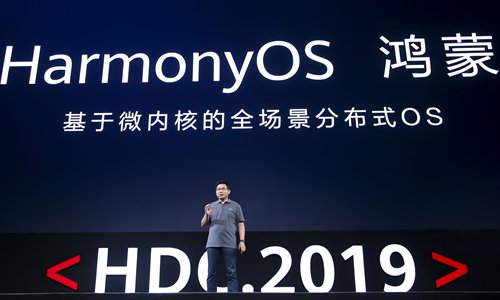HOME >> BUSINESS
Huawei launches HarmonyOS, could replace Android at ‘any time’
By Chen Qingqing in Dongguan and Li Xuanmin in Beijing Source:Global Times Published: 2019/8/9 16:26:08 Last Updated: 2019/8/10 9:35:46

Yu Chengdong, CEO of Huawei's consumer business, unveils the company's HarmonyOS on Friday in Dongguan, South China's Guangdong Province. Photo: Courtesy of Huawei
Chinese telecommunications giant Huawei released its much-anticipated operating system HarmonyOS on Friday amid the US ban still that is imposed on the company and escalating China-US trade tensions. A Huawei executive said the groundbreaking move, considered a Plan B that the company has long prepared, could be used at any time if the company is no longer able to access Google's Android.
The future-oriented, microkernel-based distributed OS will focus on delivering seamless experiences on the Internet of Things and artificial intelligent-powered connected devices. It can be run in various devices, including smartphones, wearable devices and laptops. HarmonyOS was widely referred to as HongMeng in previous media reports.
Huawei will launch HarmonyOS-equipped smart screen products this year. In the next three years, HarmonyOS will gradually be adopted across a broad range of smart devices, including wearable devices, smart screens (Huawei Vision) and car head units.
"If we can't use Google's Android anymore, we can use our own OS anytime if needed," Richard Yu Chengdong, CEO of Huawei consumer business, said at Huawei's Developer Conference on Friday in Dongguan, South China's Guangdong Province.
Google's share price slipped on Friday morning.
Yu said that the birth of HarmonyOS comes from Huawei's desire to further improve the OS' capacity to run across different platforms, including supporting all scenarios across a broad range of devices and platforms, while achieving strong safety and low latency.
"In contrast to Android and [Apple's] iOS system, HarmonyOS was developed for the future," Yu said. "You can develop your apps, then flexibly deploy them across a range of different devices."
The HarmonyOS adopts leading technologies, which enable response latency of apps to drop by 25.7 percent compared with the current system, while the inter-process communication performance could be up to five times more efficient than existing systems.
Yu said Huawei wants to build HarmonyOS into the most open OS and ecosystem. As ecosystem was the key in developing HarmonyOS, the new OS will be an open source platform. And Huawei will also establish an open-source foundation and open-source community to fast-track the ecosystem's growth.
Challenging Android
Industry observers said that HarmonyOS is Huawei's alternative in the face of maximum pressure from the US government and its flip-flopping approach in dealing with China-US trade negotiations. It will also give a huge boost to homegrown core technologies in China amid the US crackdown on Chinese technologies.
"From zero to the first step, this is the beginning of a new era! Chinese companies have conquered one of the most challenging sectors in the electronic information industry," Xiang Ligang, director-general of the Beijing-based Information Consumption Alliance, told the Global Times.
Huawei began developing its own OS in 2017. The company was able to launch HarmonyOS in a very short time, which reflects its strong research and development ability and long-term strategy in enhancing its core competitiveness, an industry insider surnamed Li told the Global Times.
Since the US Commerce Department put Huawei on a blacklist in mid-May, Huawei engineers and software programmers have worked round-the-clock to develop HarmonyOS, another source close to the matter told the Global Times.
"External pressure has united Huawei staff. We've seen less internal conflicts and strive to do better," Yu told the Global Times on Friday, noting that he has worked long hours since then. The company has been looking at difficulties in a very positive way, and "we can and will survive," he said.
"If the US continues to block and ban shipments to Huawei [and other Chinese firms], Chinese developers will ramp up efforts to develop applications that accommodate HarmonyOS, and Huawei is able to develop a strongly competitive ecosystem based on its Chinese market. As a separated OS is formed and matured, HarmonyOS will challenge Android in the global market," Li said.
The developer conference has attracted about 1,500 Huawei partners in the industrial chain and 5,000 global developers, which also bodes well for a quick expansion of the HarmonyOS ecosystem.
The launch signals a new milestone not only for Huawei but also for China's tech industry, Yu said. He noted that "it is not necessarily a bad thing" for Huawei if Washington continues forcing the company to cut ties with US firms. "It will push us to come up with Plan B, and accelerate homegrown technologies," he said.
The HarmonyOS ecosystem can also replace Windows and Android ecosystems, but Huawei still wants to cooperate with US partners, Yu said.
In May, the US government abruptly banned American companies from providing key components and equipment to Huawei over alleged national security reasons. Google followed this order and partially limited Huawei's access to its Android system.
Then, following a consensus reached between Chinese and US leaders at the G20 Summit in Japan, the US government said in June that American businesses could apply for special licenses to supply goods to Huawei. However, Bloomberg News quoted sources close to the matter as saying on Thursday that Washington is holding off on such a decision as China-US trade relations worsen.
"In the long term, US companies will be more affected," Yu said.
In 2019, Huawei saw continued fast growth despite the US crackdown. In the first half of the year, Huawei smartphones controlled 35 percent of the Chinese market and 17.6 percent globally, Yu said. And Huawei is expected to ship 240 million smartphones this year to become the second largest global vendor.